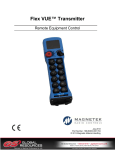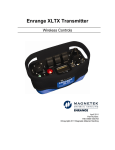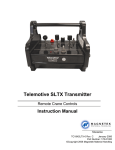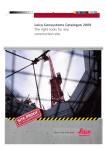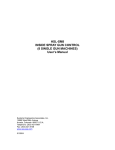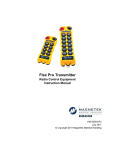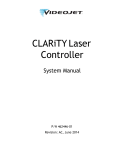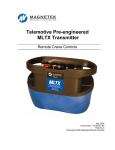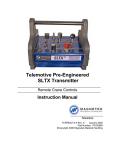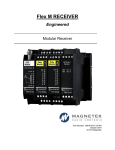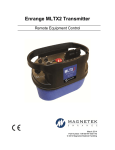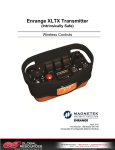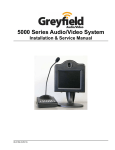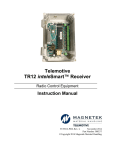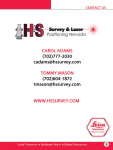Download Telemotive Series 18K Receiver
Transcript
® Telemotive Series 18K Receiver Radio Control Equipment Instruction Manual TC18K-0 Rev. P July 2006 Part Number 24559T ©Copyright 2006 Magnetek Material Handling Telemotive Series 18K Receiver Instruction Manual Table of Contents Section Page # Service Information ................................................................................................. 1-1 Radio Controlled Crane Safety............................................................................... 2-1 General System Information................................................................................... 3-1 Installation Procedure ............................................................................................. 4-1 18K Receiver Overview ........................................................................................... 5-1 18K Receiver Spare Parts ....................................................................................... 6-1 18K CPU Board........................................................................................................ 7-1 Transmitter Operation ............................................................................................ 8-1 18K RF Translator Board ....................................................................................... 9-1 18K Relay Output Boards ..................................................................................... 10-1 18K Power Supply Board...................................................................................... 11-1 18K Contact Monitoring Board............................................................................ 12-1 18K Stepless Output Boards ................................................................................. 13-1 18K Static Stepless Output Boards ...................................................................... 14-1 18K DC Backplane................................................................................................. 15-1 Telemotive Series 18K Receiver Instruction Manual i Table of Contents (Continued) Telemotive Series 18K Receiver Instruction Manual ii Section 1 – Service Information Your New Radio Receiver Thank you for your purchase of Magnetek’s Telemotive® Brand 18K Receiver. Magnetek has set a whole new standard in performance, dependability, and value with its unique new line of receivers. Without a doubt, our Telemotive 18K Receiver is the ultimate solution for having precise, undeterred, and safe control of your material. If your product ever needs modification or service, please contact one of our representatives at the following locations: U.S. Service Information For questions regarding service or technical information, contact: 1-866-MAG-SERV (1-866-624-7378). Magnetek Material Handling N49 W13650 Campbell Drive Menomonee Falls, WI 53051 Telephone: 800-288-8178 Website: e-mail: www.magnetekmh.com [email protected] Fax Numbers Main: 800-298-3503 Sales: 262-783-3510 Service: 262-783-3508 For Canada Service Information Contact Berlet Electronics: Phone: 1-905-564-2710 Fax: 1-905-564-2755 Telemotive Series 18K Receiver Instruction Manual 1-1 Telemotive Series 18K Receiver Instruction Manual 1-2 Section 2 - Radio Controlled Safety Warnings, Cautions And Notes. Throughout this document WARNING, CAUTION and NOTE statements have been deliberately placed to highlight items critical to the protection of personnel and equipment. WARNING – A warning highlights an essential operating or maintenance procedure, practice, etc. which if not strictly observed, could result in injury or death of personnel, or long term physical hazards. Warnings are highlighted as shown below: WARNING CAUTION – A caution highlights an essential operating or maintenance procedure, practice, etc. which if not strictly observed, could result in damage to, or destruction of equipment, or loss of functional effectiveness. Cautions are highlighted as shown below: CAUTION NOTE – A note highlights an essential operating or maintenance procedure, condition or statement. Notes are shown as below: 2-1. Critical Installation Considerations. WARNING ALL EQUIPMENT MUST HAVE A MAINLINE CONTACTOR INSTALLED AND ALL TRACKED CRANES AND SIMILAR EQUIPMENT MUST HAVE A BRAKE INSTALLED. FAILURE TO FOLLOW THIS WARNING COULD RESULT IN SERIOUS INJURY OR DEATH AND DAMAGE TO EQUIPMENT. WARNING ON ALL REMOTE CONTROLLED CRANES AN AUDIBLE AND/OR VISUAL WARNING MEANS MUST BE PROVIDED. THESE AUDIBLE AND/OR VISUAL WARNING DEVICES MUST MEET ALL GOVERNMENTAL REQUIREMENTS. FAILURE TO FOLLOW THIS WARNING COULD RESULT IN SERIOUS INJURY OR DEATH AND DAMAGE TO EQUIPMENT. NOTE WARNINGS, CAUTIONS AND NOTES SHOULD NEVER BE DISREGARDED. The safety rules in this section are not intended to replace any rules or regulations of any applicable local, state, or federal governing organizations. Always follow your local lockout and tagout procedure when maintaining any radio equipment. The following information is intended to be used in conjunction with other rules or regulations already in existence. It is important to read all of the safety information contained in this section before installing or operating the Radio Control System. WARNING PLEASE FOLLOW YOUR LOCAL LOCKOUT TAGOUT PROCEDURE BEFORE MAINTAINING ANY REMOTE CONTROL EQUIPMENT. ALWAYS REMOVE ALL ELECTRICAL POWER FROM THE CRANE OR MACHINERY BEFORE ATTEMPTING ANY INSTALLATION PROCEDURES. DEENERGIZE AND TAGOUT ALL SOURCES OF ELECTRICAL POWER BEFORE TOUCH TESTING ANY EQUIPMENT. FAILURE TO FOLLOW THIS WARNING COULD RESULT IN SERIOUS INJURY OR DEATH AND DAMAGE TO EQUIPMENT. Telemotive Series 18K Receiver Instruction Manual 2-1 Section 2 - Radio Controlled Safety (Continued) 2-4. Training Checklist For Crane Operators. WARNING THE DIRECT OUTPUTS OF THIS PRODUCT ARE NOT DESIGNED TO INTERFACE DIRECTLY TO TWO STATE SAFETY CRITICAL MAINTAINED FUNCTIONS, I.E., MAGNETS, VACUUM LIFTS, PUMPS, EMERGENCY EQUIPMENT, ETC. A MECHANICALLY LOCKING INTERMEDIATE RELAY SYSTEM WITH SEPARATE POWER CONSIDERATIONS MUST BE PROVIDED. FAILURE TO FOLLOW THIS WARNING COULD RESULT IN SERIOUS INJURY OR DEATH AND DAMAGE TO EQUIPMENT. 2-2. General. Radio controlled overhead cranes and other material handling equipment operate in several directions. They are large, bulky pieces of equipment that handle heavy loads efficiently at high speeds. Quite frequently, the equipment is operated in areas where people are working on the floor below. The crane operator must exercise extreme caution at all times. Workers must constantly be alert to avoid accidents. The following rules have been included to indicate how your careful and thoughtful actions may prevent injuries, damage to equipment, or even save a life. If radio controlled material-handling equipment is operated from the cab, special care must be taken to secure the transmitter. Refer to section titled Section 2-7.3. Boarding The Crane for specific safety rules. 2-3. Persons Authorized To Operate Radio Controlled Cranes. Only properly trained persons designated by management should be permitted to operate radio-controlled cranes. Radio controlled cranes should not be operated by any person who cannot read or understand signs, notices and operating instructions that pertain to the crane. Radio controlled cranes should not be operated by any person with insufficient eyesight or hearing or by any person who may be suffering from a disorder or illness or is taking any medication that may cause loss of crane control. Anyone being trained to operate a radio-controlled crane should possess as a minimum the following knowledge and skills before operating the crane: The operator should have knowledge of hazards pertaining to crane operation. The operator should have knowledge of the safety rules for radio-controlled cranes. The operator should have the ability to judge distance of moving objects. The operator should have knowledge of the radio transmitter. The operator should know how to properly test limit switches. The operator should know, where authorized, instructions for plugging motions. The operator should have knowledge of the use of crane warning lights and alarms. The operator should have observing crane signal lights. knowledge of The operator should be trained to avoid striking any obstructions. The operator should have knowledge of the proper clearance of lifts or hooks before moving bridge or trolley. The operator should have knowledge of the proper storage space for radio control transmitter when not in use. The operator should be trained in transferring radio control transmitter to another person. The operator should be trained how and when to report unsafe or unusual operating conditions. The operator should be trained how to exhibit caution in approaching bridge or trolley bumpers. The operator should know equipment capacity. The operator should be trained in making lifts below floor level. Telemotive Series 18K Receiver Instruction Manual 2-2 Section 2 - Radio Controlled Safety (Continued) The operator should be trained in making side pulls. The operator should know how to keep himself and other people clear of lifts and to avoid "pinch" points. The operator should know cable and hook inspection procedures. The operator should know procedures for testing hoist, trolley, and bridge brakes. The operator should know and follow the local lockout and tagout procedures. 2-5. Operating Area. Aisles between equipment, stock, etc., should be free of obstructions so the crane operator can move freely. These aisles should be a minimum of three feet (one meter) wide, or meet local regulations. Crane operators should always position themselves for the best view of the crane they are controlling. The crane should never be operated blindly. The operator should stay as close to the crane load as possible. Operators should never position themselves in a "pinch" point. 2-6. Transmitter Unit. Test the upper-limit switch. Slowly raise the unloaded hook block until the limit switch trips. When checking limit switches the hoist should be centered over an area free of personnel and equipment. Visually inspect the hook, load lines, trolley, and bridge as much as possible from the operator's station; in most instances, this will be the floor of the building. The bridge and trolley brakes should be tested. On transmitter units equipped with two or more speeds, use the "lowest" speed when testing braking devices. When lifting maximum loads, the crane operator should test the hoist brakes by raising the load a few inches from the floor. If the brakes do not hold, the load should immediately be lowered to the floor. If provided, test the lower-limit switch. Test all warning devices. Test all direction and speed controls for both bridge and trolley travel. Test all bridge and trolley limit switches, where provided, if operation will bring the equipment in close proximity to the limit switches. Transmitter switches should never be mechanically blocked ON or OFF for any crane motion. When not in use turn the transmitter OFF. A secure storage space should be provided for the transmitter unit and the transmitter unit should always be placed there when not in use. This precaution will prevent unauthorized people from operating the crane. Test the transmitter emergency stop. Spare transmitters should be stored in a secure storage space and only removed from the storage space after the current transmitter in use has been turned OFF, taken out of the service area and secured. 2-7.2. General Rules For Operation. Test the hoist brake to verify there is no drift without a load. If any crane or hoist fails any of the above tests notify the supervisor and lockout and tagout for repair. Consult the crane manufacturer, local and governmental regulations for complete rules of operation. In general the following rules apply to remotely controlled cranes: 2-7. Operating The Crane. 2-7.1. Pre-operation Test The limit switches should never be used as a regular stopping device. They are intended to be protective devices. At the start of each work shift, or when a new operator takes control of the crane, operators shall do, as a minimum, the following steps before making lifts with any crane or hoist: Do not make lifts in excess of the equipment rated capacity. Telemotive Series 18K Receiver Instruction Manual 2-3 Section 2 - Radio Controlled Safety (Continued) The bridge and trolley should be centered directly over the load when the load is raised to prevent swinging when making lifts. A crane designed for this purpose and only with supervisor permission should make side pulls. When a lift is being made, the crane operator should not be positioned in the line of travel. The crane or hoist should be operated from a position either to the side or opposite from the direction of travel. When raising or lowering a load, proceed slowly and make certain the load is under control. Tag lines should be used for handling unusual lengths or bulky loads. Remove slack from chains or slings gradually. Make certain all personnel are clear before making a lift. The crane operator should keep all body parts away from the lift and should never be positioned under the lift. Do not make a lift or move a load if anyone is in a location where they could be struck by the crane or the load. If the crane operator is being assisted, the crane should not be moved until the assistant signals they are clear of the crane and its load. When a load is hanging from the crane hook and the crane is being moved, the crane operator should sound all warning devices frequently. Loads should not be carried over workers heads. If a worker is in the path of crane travel, the crane operator should stop the crane and clear the area before proceeding. Runway stops or other cranes should never be bumped into. When moving the crane, the crane operator should be sure that the hook block and attachments or cables will not catch on nearby equipment. Slings, chains, or cables should never be dragged along the floor. The crane operator should always hoist lifts high enough to clear all equipment and workers. The crane operator should never permit anyone to ride on the load or hook except when authorized by the supervisor. When another crane on the same runway is stationary with a load hanging, the crane operator should maintain a safe distance between the stationary crane and the one under their control. Never leave suspended loads unattended. In an emergency, if the crane is inoperative and a load suspended, notify the supervisor immediately, barricade and post signs on the floor beneath crane and load. If power to the crane is removed, the crane operator should turn the transmitter unit OFF and keep it OFF until power is restored. If the crane fails to respond properly, the crane operator should stop operation, turn the transmitter unit OFF and immediately report the condition to their supervisor. Outdoor cranes, which are subject to movement by wind, should be securely anchored when left unattended. If the crane is equipped with bridge brakes, the parking brake should be set immediately. 2-7.3. Boarding The Crane. The crane should not be boarded without permission of the supervisor. The crane operator should turn off the transmitter and take it with them when boarding the crane. If more than one person is boarding the crane, one person should be made responsible for ensuring all personnel are off the crane before the system is returned to operation. 2-8. Crane Maintenance And Repair. Unless required for operator safety, gloves should not be worn when operating the transmitter unit. All loose materials or parts should be removed from the load before starting the lift. Qualified personnel must maintain a regularly (i.e., such as monthly) scheduled crane inspection. During this crane inspection the functionality and safety of the crane remote control must also be tested. The inspection shall include, but not be limited to items listed in Section 1-13. Condition of The Radio Controlled Telemotive Series 18K Receiver Instruction Manual 2-4 Section 2 - Radio Controlled Safety (Continued) Crane. Consult crane manufacturer, local and governmental regulations for recommended inspection intervals and proper inspection procedures. Problems noted during this inspection must be repaired before using the crane or the remote control. stop prior to entering the restricted area and should proceed through this area only after receiving permission from a signal person designated for this purpose. Access of persons to and from the crane being repaired should be under control of the repair crew leader. Minor repairs include routine maintenance and repairs such as greasing, cleaning and control troubleshooting. All other repairs should be considered major. If the repair crew consists of more than one person, one person should be designated as the repair crew leader with the following responsibilities. If the repair crew consists of only one person, that person has the following responsibilities: When boarding the crane, the transmitter should be turned OFF and the transmitter should remain with the repair crew leader. The leader should board the crane first, open and lockout the main switch, and then signal the other members of the crew it is safe to board the crane. For minor repairs, warning signs should be placed on the floor beneath the crane or suspended from the crane. For major repairs, the floor area below the crane should be roped off. When major repairs are to take place, all persons operating other cranes on the same or adjacent runways, if any, must be notified prior to starting repairs. Notification should include the nature of the repair, safeguards provided, and movement limitations while repairs are in progress. When practical, radio controlled cranes which cannot be moved during repairs must be protected against being bumped by other cranes on the runway. Bumpers should be installed on the exposed side or sides of the crane under repair. They should be placed as far away as possible. The location of these bumpers should be indicated by red lights placed so that they are clearly visible to other crane operators traveling on the same runway. When it is not possible to use bumpers, red lights must be placed so they are clearly visible to other crane operators traveling on the same runway to indicate the restricted travel zone. All crane operators on the same runway must be informed of the repair effort and thoroughly instructed to what their operations are limited to and informed they will be notified when repairs are completed. If any hazard involving the repairperson exists when there is a runway adjacent to the crane under repair, the adjacent runway should be blocked off as described above. When it is necessary to continue crane operation on the adjacent runways, warning lights must be installed and be visible to operators of cranes on those runways. All cranes should come to a complete If work on the crane is to be done in areas not protected by standard handrails, the repair crew should wear approved safety belts. All tools and equipment should be moved onto the crane by the use of hand lines. The tools and equipment should be adequately secured to the hand lines. If it is necessary to have the crane control circuits energized, all power circuits for crane movement must be opened prior to energizing the control circuits. All personnel and tools should be moved to a safe spot before moving the crane during repairs. Headroom is at a minimum in some crane cabs and on some crane walkways. Caution should be exercised when boarding or working on cranes. Hard hats should be worn whenever possible. When repairs are finished, all personnel, tools and repair equipment should be removed before energizing the crane circuits. 2-9. Using The Crane As A Work Platform. When the crane is to be used as a stationary work platform, follow all rules provided in Section 111. Crane Maintenance and Repair. When it is necessary for the crane to be moved from time to time, the crane operator should board the crane with the transmitter unit. The crane operator should ensure all personnel working on the crane are in a secure position before moving the crane to the next workstation. It should also be the crane operator’s responsibility to ensure the main switch is open and locked down before work is resumed. Telemotive Series 18K Receiver Instruction Manual 2-5 Section 2 - Radio Controlled Safety (Continued) Protective guards are in place for all moving parts. WARNING THE CRANE OPERATOR SHOULD NOT ATTEMPT TO REPAIR ANY OF THE ITEMS STATED BELOW. THE CRANE CONDITION SHOULD BE REPORTED TO THE SUPERVISOR. FAILURE TO FOLLOW THIS WARNING COULD RESULT IN SERIOUS INJURY OR DEATH AND DAMAGE TO EQUIPMENT. 2-10. Condition Of The Radio Controlled Crane. If the crane fails to respond properly, the crane operator(s) should notify their supervisor. When serious conditions are noticed (conditions that make the crane unsafe to operate), the crane should be shut down immediately and the supervisor notified. The following is a list of some of the items that should be included in the report (See the crane manufacturer for specifics and possible additional items): Condition of hoisting cable and hook block (broken strands, clipped sheave wheels, etc.). Condition of brakes (hoist, trolley, and bridge). (No bluing, rivets on shoes showing, glazing, etc.). Condition of trolley and rail stops. Alignment of bridge (screeching or squealing wheels indicate bridge is out of line). Broken, cracked, or chipped rails on trolley or runway. Condition of limit switches. Condition of electrical and mechanical control (electrical or mechanical defects which cause faulty operation such as uncommanded stopping or starting of any crane motions, warning devices, lights, or auxiliary functions). Condition of gears (grinding or squealing may indicate foreign materials in gear teeth or a lack of lubrication.) All controls (especially E-STOPs) are in place and in working order. Frequent relay tripping of power circuits. Mechanical parts loosened by vibration (loose rivets, covers, bolts, etc.). Uneven riding (worn or damaged wheels). Condition of collector shoes or bars. Condition of warning or signal lights and horns. (burned out or broken). 2-11. Batteries Condition of bridge structure. Condition of festoon system. Broken welds in any part of the crane structure. Proper fluid levels and lubrication. Condition of bridge and trolley stops. Carbon dust or signs of burning on the covers of motors. Indication of fluid, oil or grease leaks. Condition of rail sweeps. WARNING KNOW AND FOLLOW PROPER BATTERY HANDLING, CHARGING AND DISPOSAL PROCEDURES. IMPROPER BATTERY PROCEDURES CAN CAUSE BATTERIES TO EXPLODE OR DO OTHER SERIOUS DAMAGE. FAILURE TO FOLLOW THIS WARNING COULD RESULT IN SERIOUS INJURY OR DEATH AND DAMAGE TO EQUIPMENT. Walkways require handrails and ladders are sturdy and in place, not loose. 2-12. Battery Handling. Telemotive Series 18K Receiver Instruction Manual 2-6 Section 2 - Radio Controlled Safety (Continued) Use only batteries approved by Telemotive for the specific product. Avoid charging the battery pack for more than 24 hours at a time. Do not dispose of a battery pack in fire; it may explode. Do not charge batteries in a hazardous environment. Do not attempt to open the battery pack. Do not short the charger. Do not short circuit battery. Do not attempt to charge a damaged battery. For intrinsically safe environments only use specified Telemotive intrinsically safe batteries. Keep the battery pack environment cool during charging operation and storage, (i.e., not in direct sunlight or close to a heating source). 2-13. Battery Charging. For those transmitters equipped with battery chargers, please familiarize all users with the instructions of the charger before attempting to use. Use only Telemotive approved chargers for the appropriate battery pack. Do not attempt to use a battery that is leaking, swollen or corroded. Charger units are not intended for outdoor use. Use only indoors. 2-14. Battery Disposal. Before disposing of batteries consult local and governmental regulatory requirements for proper disposal procedure. Do not attempt to charge non-rechargeable battery packs. Telemotive Series 18K Receiver Instruction Manual 2-7 Telemotive Series 18K Receiver Instruction Manual 2-8 Section 3 – General System Information 3-1. General System Information. The Series 18K Radio Control System (system) provides remote control of overhead cranes using radio signals. The system consists of a hand held portable battery operated transmitter unit and a fixed station receiver unit. Each system has its own access code, which permits a receiver unit to respond only to a transmitter unit with the same access code. Up to four transmitters may be used with the same frequency. Each transmitter operating on the same frequency may be operated in close proximity (not less than six feet) to each other. Access Code: Any received signal, which does not match the receiver access code, is considered invalid by the receiver. NOTE DETERMINE IF YOUR SYSTEM IS FCC PART 15 OR PART 90. IF THE RECEIVER HAS THE PART NUMBER 18087 ON THE DOOR OR YOUR TRANSMITTER HAS A PUSH BUTTON FOR ON/OFF RATHER THAN A TOGGLE SWITCH IT IS FCC PART 15. 3-2. FCC Regulations. There are two types of radio-controlled systems. One is high power licensed (FCC Part 90) and low power unlicensed (FCC Part 15). Both give more than adequate range, security and features, however there are subtle differences in operation required by FCC rules and regulations. It is helpful to know with system type you have to troubleshooting and servicing. 3-3. Signaling (TMS and Continuous). TMS (Time Multiplexed Signaling) is a Telemotive propriety high-speed packet data system. That transmits data in pulses. Continuous Carrier signaling means the transmitter is continuously transmitting power whether or not a lever or function is activated. Continuous carrier systems tend to be older systems. 3-4. Part 90 (TMS And Continuous Carrier). For 18K licensed systems, the transmitter unit is frequency modulated, has relatively high power (greater than 100 mW typically) and a licensed is required licensed under Part 90 of FCC rules and regulations. The transmitter unit uses crystalcontrolled oscillators to set the operating frequency. 3-5. Part 15 (TMS only). For 18K systems with part 15 signaling, the transmitter unit is frequency modulated, lower power and is certified under part 15 of FCC rules and regulations. A license is not required for the transmitter or operator. The transmitter unit uses crystal-controlled oscillators to set the operating frequency. A power down feature turns the transmitter unit OFF if no keys are pressed for an extended (approximately 15 minutes) period of time. The transmitter unit must again be turned ON. A configuration of the transmitter unit is available without automatic timeout. A LED mounted on the front panel provides battery voltage and data transmission status. 3-6. Receiver Unit. The receiver unit consists of an RF receiver module, microprocessor control module, output relay/control modules and a power supply. A power down feature turns the receiver unit OFF if no commands are received for an extended (approximately 15 minutes) period of time. A configuration of the receiver unit is available without automatic time out. 3-7. Part 15 System Specifications. Channel Designations: (The channels listed here are for reference purposes and are not an indication of production stock. Some channels may take extended delivery contact Telemotive for availability). AK01 - 439.8 MHz AK02 - 439.6 MHz AK03 - 439.4 MHz AK04 - 439.2 MHz AK05 - 439.0 MHz AK06 - 438.8 MHz AK07 - 438.6 MHz AK08 - 438.4 MHz AK09 - 438.2 MHz AK10 - 438.0 MHz AK11 - 437.8 MHz AK12 - 437.6 MHz AK13 - 437.4 MHz AK14 - 437.2 MHz AK15 - 437.0 MHz AK16 - 436.8 MHz AK17 - 436.6 MHz AK18 - 436.4 MHz AK19 - 436.2 MHz AK20 - 436.0 MHz Telemotive Series 18K Receiver Instruction Manual 3-1 Section 3 – General System Information (Continued) AKA00 - 433.125 MHz AKA01 - 433.325 MHz AKA02 - 433.525 MHz AKA03 - 433.725 MHz AKA04 - 433.925 MHz AK50 - 430.0MHz AKA05 - 434.125 MHz AKA06 - 434.325 MHz AKA07 - 434.525 MHz AKA08 - 434.725 MHz AK38 - 432.4 MHz Ambient Operating Conditions - -22°F to +158°F (-30°C to +70°C). Humidity - up to 95% (non-condensing). Typical Operating Range - 300 feet. Up to four transmitter units may operate on the same frequency while in close proximity (not less than six feet) to each other. designed so that a transmitter will send a signal for a predetermined ON time, and then will turn OFF. The length of transmitter ON time is referred to as data burst or packet. The packet length is a function of the quantity of data to be sent, and the data rate (baud). Once the packet is sent, the transmitter will turn OFF. This allows for other transmitters to time-share the same frequency when a transmitter has turned OFF. The TMS system software determines the OFF period and repetition rate of the ON period. This allows up to 4 transmitters to share and have equal access to the same frequency, and also allows for reduced battery consumption and extended battery life. 3-8. Time Multiplex Shared (TMS) System Software. The system software is structured to minimize "on the air" transmission time of any transmitter. This allows for multiple transmitters to share a common frequency. The TMS system is Telemotive Series 18K Receiver Instruction Manual 3-2 Section 4 – Installation Information 4-1. Pre-Installation Considerations. 4-3. Antenna Mounting Considerations. To ensure reliable and safe operation of the system, the following items must be considered before installing the receiver unit. It is best to mount the antenna so that it is visible to the operator. Usually, this is accomplished by mounting the antenna under the crane and pointed down. You should always try to avoid power sources, motors, drives, brakes, etc. If necessary, we offer an external antenna kit NOTE THIS MANUAL IS A GENERAL MANUAL FOR 18K SYSTEMS. EVERY 18K SYSTEM COMES WITH A COMPLETE SET OF SYSTEM DRAWINGS SPECIFIC TO THE CUSTOMER’S ORDER. THESE DRAWINGS SUPPLY NEEDED INFORMATION ABOUT SPECIFIC FEATURES, OPERATION, WIRING AND MOUNTING. DO NOT ATTEMPT TO INSTALL OR OPERATE THIS SYSTEM WITHOUT THEM. IF YOU NEED ADDITIONAL COPIES PLEASE CONTACT TELEMOTIVE. IN ALL CORRESPONDENCE WITH TELEMOTIVE ABOUT YOUR SPECIFIC SYSTEM PLEASE REFERENCE THE JOB LISTED ON THE FRONT OF YOUR EQUIPMENT. WARNING THE RECEIVER UNIT OR RELAYS ARE NOT RATED AS EXPLOSION PROOF. THE RECEIVER UNIT MUST NOT BE INSTALLED IN EXPLOSIVE ENVIRONMENTS UNLESS APPROPRIATE SECONDARY ENCLOSURE MEASURES ARE TAKEN. FAILURE TO FOLLOW THIS WARNING COULD RESULT IN SERIOUS INJURY OR DEATH AND DAMAGE TO EQUIPMENT. The receiver unit should not be subjected to moisture. 4-4. Line Input Considerations. Check the system drawings for proper line input voltage. If there is any question as to proper line input voltage contact Telemotive before applying power to the unit. WARNING THE UNIT MUST BE WIRED TO THE CORRECT VOLTAGE, AND BE CONNECTED TO THE CORRECT TERMINAL AS REQUIRED BY THE ACTUAL LINE VOLTAGE. PLEASE CONSULT YOU SYSTEM DRAWINGS FOR PROPER SUPPLY VOLTAGES. FAILURE FOLLOW THIS WARNING COULD RESULT IN SERIOUS INJURY OR DEATH AND DAMAGE TO EQUIPMENT. NOTE THE RECEIVER UNIT SHOULD NOT BE CONNECTED TO LINES CONTAINING EXCESSIVE POWER UP TRANSIENTS OR CONTINUOUS COMMUTATOR NOISE. A LINE CONDITIONER MAY BE NECESSARY IN SOME INSTALLATIONS. 4-5. Wiring Considerations. 1. Do not connect or disconnect wiring, or perform circuit checks while the power is turned ON. Ensure the mounting location is as far as possible from exposed trolley wires and sources of electromagnetic or radiated noise. 2. The motor wiring shall be in a separate metal conduit from the power wiring, which shall also be in metal conduit. If possible, avoid installing receiver unit to a surface where high vibration or shock is present. If this cannot be avoided, use appropriate shock mounts. 3. Low voltage wires shall be wired with Class 1 wiring. 4. Control wiring as well as antenna wiring shall be in separate conduit and shall be kept as short as possible. 4-2.Receiver Unit Mounting Location Considerations. Telemotive Series 18K Receiver Instruction Manual 4-1 Section 4 – Installation Information (Continued) 5. Control wiring for stepless devices shall be shielded twisted pair. The shield should be grounded at both ends. 6. All terminals shall be tightened to specified terminal torque (4.4 IN-LBS. unless otherwise specified). 7. Please observe National Electric Code (NEC) when wiring electrical devices. 8. When cutting holes in cabinet take care to prevent metal filings from shorting circuitry. Remove excess metal screws, metal filings and wire clippings from inside of unit. MAKE SURE S1 MASTER CONTROL RELAY (MCR) IS TURNED OFF BEFORE ATTEMPTING THIS TO PREVENT ACTIVATION OF EXTERNAL CIRCUITRY. SEE SECTION 7-1 FOR SWITCH LOCATION. FAILURE TO FOLLOW THIS WARNING COULD RESULT IN SERIOUS INJURY OR DEATH AND DAMAGE TO EQUIPMENT. 9. Inspect to make sure no exposed wire has contact with any other wiring or terminals. 1. Ensure mounting location is as far as possible from exposed Trolley wire and sources of electromagnetic or radiated noise. Antenna should be pointed straight up. 2. Mount unit and install antenna. For remotely mounted antennas make sure the mounting base or plate of the antenna is grounded. 3. Set switch SW1 on power supply to off position towards right of cabinet. See Section 11-1 for power supply switch location. Set switch S1 on CPU to OFF to disable receiver outputs. See Section 7-1 for CPU switch S1 location. 4. Wire unit up per supplied system drawings. 5. Wiring of the 18K system should now be complete. 6. Make sure all personnel are clear of equipment, no load is on the crane, turn ON power supply switch SW1 and apply power. (Switch S1 on the CPU is still turned OFF!). 7. A number of yellow and green lights should be ON on the CPU board. Check to see that the red DS3 is out at this time indicating the outputs are disabled. (Switch S1 on the CPU turned off). Check out radio functions Check each function and direction by first jogging the appropriate button. After the check, put S1 to the ON position, the red DS3 should light. 8. With S1 on the CPU ON, check crane operation under power. Again check each function and direction by first jogging the 4-7. Receiver Installation. WARNING 10. All receiver relays should drive contactors. Suppressors are strongly recommended on all contactors. 4-6. Receiver Unit Cabinet Mounting. Recommended mounting hardware is 1/4-20 hex machine screws of appropriate length, four 1/420 x 7/16 "keps" or elastic stop nuts. Flat washers should be used in front of nuts when receiver unit is mounted to a non-structural surface. Mount receiver unit cabinet securely to mounting surface. Actual cabinet mounting dimensions are supplied with your system drawings. A typical 18K cabinet layout is should is shown in Figure 4-1. Cabinet Layout MP18001-0. This is the most commonly used 18K cabinet. An alternate smaller cabinet is shown in Figure 4-2. Small 18K Cabinet. please verify either by the System Drawings or by physical measurement that this matches the cabinet supplied. Telemotive Series 18K Receiver Instruction Manual 4- 2 Section 4 – Installation Information (Continued) appropriate button. Installation should now be complete. 4-8. Special Receiver Functions. Special programming exists to allow some of the Aux. relays to be dedicated for special system functions. Setting certain dip switches on the CPU Board enables this programming. 4-8.1 Master Control Relay (MCR) Enable (S1). This switch, when turned to OFF, disables the MCR and removes all output power to all output relays. This allows testing of the receiver control circuitry without activating any external functions such as motors and horns. 4-8.2 Auto Alarm And E-STOP Alarm. (S2-1, S2-2) (E-STOP Alarm only available on Part 15 system). The use of either one of these two functions dedicates one specific control relay to operate an external alarm. An external alarm (not supplied) needs to be connected to this relay. The E-STOP Alarm is designed into certain Part 15 systems if required. Consult your System drawings to determine how the alarms if any are wired up. The Auto Alarm is field configurable. (See Section 4-7.3 below). In the Part 15 system only, the E-STOP Alarm turns ON when the E-STOP is depressed on the transmitter. It stays ON till the E-STOP is released. To clear an E-STOP condition the transmitter must be turned OFF and ON again. In the Part 15 system to disable the E-STOP Alarm the Auto Alarm must also be turned OFF. To disable both Auto Alarm and E-STOP Alarm turn S2-1 OFF and S2-2 ON on the CPU Board. (See Section 7-3). NOTE DO NOT USE THE E-STOP FOR NORMAL ON AND OFF OF SYSTEM. WHILE THE ESTOP IS DEPRESSED THE TRANSMITTER IS CONTINUOUSLY TRANSMITTING. LEAVING THE TRANSMITTER IN THE ESTOP CONDITION WILL IMPAIR BATTERY LIFE. 4-8.3 Auto Alarm (S2-1). Gives about 5 seconds of alarm when the transmitter is first turned ON. To enable connect an external alarm. Move dip switch S2-1 on the CPU Board to the ON position. See Section 7.1 - 18K CPU Board for switch details. For location of the Alarm Relay. See the appropriate wiring diagram supplied with your system. 4-8.4 Time-Out-Timer Enable (S3-2). The receiver contains a time-out-timer. If a receiver once turned ON by a transmitter does not receive a signal from a transmitter for a period of 15 minutes the receiver shuts down. Setting S3-2 to ON disables this function. See Section 7.1 - 18K CPU Board for switch details. Telemotive Series 18K Receiver Instruction Manual 4- 3 Section 4 – Installation Information (Continued) 26.50” 25.50” 28.375” 13.88” 29.92” MP18001-0 23.62” F A PART NUMBER All dimensions are in inches. A E B .375”Ø D B C Mounting Tabs D E .125” C F Figure 4-1. Cabinet Layout, Cabinet Part Number MP18001-0. (Check System Drawings to verify this is correct cabinet, some systems need different cabinets. Systems with a different cabinet come with unique mounting information). NOTE For MP18001-0 Cabinet, the Mounting Tabs must be remounted (turned outward) on back of cabinet before installation. These are shipped attached to the back of the cabinet, but turned inward for shipping. Telemotive Series 18K Receiver Instruction Manual 4-4 Section 4 – Installation Information (Continued) Figure 4-2. Small 18K Cabinet Telemotive Series 18K Receiver Instruction Manual 4-4 4-5 Section 5 – 18K Receiver Overview 5-1. 18K Receiver Overview. A typical 18K receiver back panel layout is shown in Figure 5-1. Refer to Section 6 - 18K Receiver Spare Parts for additional part numbers. For specific part numbers for the system refer to the Bill of Materials in the System Drawings. Circuit Breaker CB100-1 Fuses F108-0 Suppressor CR2105-0 An optional smaller cabinet is available for smaller sized systems see the System Drawings for layout and mounting details. Output Boards (selected per system) E10112-0 – 8 NO Contacts (green) E10115-0 – 4 NO & 4 NC Contacts (red) E10109-X – Stepless Two Motor E10116-X – Stepless One Motor 2 Aux.s Receiver (Part 15) E13158-D 5. 4. 18K CPU Board E10111-0 RF Translator E10108-X Relays K206-31 Jumpers WA1037-0 Contact Monitoring Board (optional) E10191-X 1. 2. Wire Duct W126-0 Wire Duct Cover W127-0 1. Transformer T122-0 3. Power Supply Board E10171-0 Terminal Blocks TB2703-0 (For one block, typical 70 blocks) Channel Mount MP803-0 Figure 5-1. Typical 18K Receiver. Cables (1). RS485 cable (2). DC power cable (3). Power supply cable (4). RS485 cable (5). 6-conductor cable Part numbers: WA18002-30 WA1045-37 WA1039-0 WA18002-13 WA1006-13 Telemotive Series 18K Receiver Instruction Manual 5-1 2. Telemotive Series 18K Receiver Instruction Manual 5-2 Section 6 – 18K Receiver Spare Parts 6-1. 18K Receiver Spare Parts. The following parts are listed for reference only. Please always check the Bill of Materials in the System Drawings to verify part numbers. PART NUMBER BOARD LEVEL E13158-D E7160-X E7170-X E8055-20 E10108-0 E10111-0 E10171-0 T122-0 E10112-0 E10109-0 E10115-X E10116-X E10110-X FW2874-0 FW2872-0 FW2873-0 FW2890-0 FW2894 E10191-X FW2871-0 K2116-1 K1304-0 F2711-0 F2711-1 F2711-3 INTERNAL WIRING WA1039-0 WA1045-37 WA1006-13 DESCRIPTION UHF RECEIVER MODULE (PART 15 ONLY) VHF RECEIVER MODULE (LICENSED ONLY) SEE SYSTEM DRAWINGS FOR SPECIFIC MODEL UHF RECEIVER MODULE (LICENSED ONLY) SEE SYSTEM DRAWINGS FOR SPECIFIC MODEL 20DB PAD FOR LICENSED RECEIVER (PART 90 ONLY) RF TRANSLATOR BOARD CPU (COMPUTER or DIGITAL CONTROL) BOARD POWER SUPPLY BOARD POWER SUPPLY BOARD TRANSFORMER 8 NORMALLY CLOSED RELAY BOARD (GREEN) 4 NORMALLY CLOSED AND 4 NORMALLY OPEN RELAY BOARD (RED) STEPLESS TWO MOTOR OUTPUT BOARD, SEE SYSTEM DRAWINGS FOR SPECIFIC MODEL STEPLESS ONE MOTOR, TWO AUX. OUTPUT BOARD, SEE SYSTEM DRAWINGS FOR SPECIFIC MODEL STATIC STEPLESS OUTPUT BOARD, SEE SYSTEM DRAWINGS FOR SPECIFIC MODEL CPU EPROM (MUST ORDER WITH JOB NUMBER) RF TRANSLATOR EPROMS: (PART 15) (PART 90 TMS) (PART 90 CONTINUOUS CARRIER) (PART 90 TDMA) CONTACT MONITORING BOARD, (OPTIONAL) SEE SYSTEM DRAWINGS FOR SPECIFIC MODEL (110VAC MODEL E10191-0) CONTACT MONITORING BOARD EPROM RELAY DPST-N.O. 25A, 12VDC COIL (POWER SUPPLY BOARD) RELAY SPDT, 16A, 12VDC COIL (RELAY OUTPUT BOARDS) FUSE, 10A, 250V, 5X20mm SLO-BLO FUSE, 1.0A, 250V, 5X20mm SLO-BLO FUSE, 0.3A, 250V, 5X20mm SLO-BLO POWER SUPPLY TO CPU BOARD CABLE POWER CABLE CONTACT MONITORING TO POWER SUPPLY BOARD 6-CONDUCTOR CABLE 13 INCH (FOR BACK PANEL MOUNTED RF TRANSLATOR BOARD TO CPU) Telemotive Series 18K Receiver Instruction Manual 6-1 Section 6 – 18K Receiver Spare Parts PART NUMBER DESCRIPTION INTERNAL WIRING (CONTINUED) WA1006-45 6-CONDUCTOR CABLE 45 INCH (FOR DOOR MOUNTED RF TRANSLATOR BOARD TO CPU) WA18002-13 RS485 CABLE 13 INCH (FOR BACK PANEL MOUNTED RF TRANSLATOR BOARD TO CPU) WA18002-30 RS485 CABLE 30 INCH (FOR BACK PANEL MOUNTED CONTACT MONITORING BOARD) WA18002-45 RS485 CABLE 45 INCH (FOR DOOR MOUNTED RF TRANSLATOR BOARD TO CPU) WA1088-2 LICENSED (PART 90) RECEIVER TO RF TRANSLATOR BOARD CABLE WA1037-0 CABLE JUMPERS CPU BOARD TO RELAY OUTPUT BOARDS W1098-2 JUMPER, INSULATED, 2-CIRCUITS W1098-4 JUMPER, INSULATED, 4-CIRCUITS MP803-0 CHANNEL MOUNT FOR TERMINAL BLOCKS TB2703-1 TERMINAL BLOCK MP803-0 TERMINAL BLOCK CHANNEL MOUNT CB100-1 CIRCUIT BREAKER ASSEMBLY W126-0 WIRE DUCT W127-0 WIRE DUCT COVER K206-31 CONTROL RELAY E1860-30 CONTROL RELAY ARC SUPPRESSOR CR2105-0 SUPPRESSOR F108-0, X110-0, X111-0 FUSE AND FUSE HOLDER ASSEMBLY, 1 AMP ANTENNA AN100-1 E2028-2 E525-0 E525-0 E104-0 E104-1 ANTENNA, 450 MHZ (PART 15) OPTIONAL REMOTE EXTERNAL ANTENNA KIT, 450 MHZ ANTENNA VHF, 72-75 MHZ ANTENNA VHF, IRAC BAND, 42 MHZ ANTENNA UHF, 450 MHZ ANTENNA UHF, 410 MHZ Telemotive Series 18K Receiver Instruction Manual 6-2 Section 7 – 18K CPU Board 7-1. 18K CPU Board Setup Information. 7-2. Operation. The CPU (Computer Processor Unit) Board consists of a microprocessor (EPROM) with built in custom programming. The programming RS 485 cable to of the microprocessor (EPROM) will vary from RF Interface application to application. Inquiries about the Board J3 functionality or replacement parts can be ordered by referencing the job number of the receiver JU6 unit (found on the door label) or the part number on the microprocessor (EPROM) itself. The 18K CPU Board is shown in Figure 7-1. 18K CPU Board. Refer to paragraphs 7-1. through 7-5. for servicing procedures. Power Cable to RF Interface Board J1 J4 J7 J18 J6 J17 U1 DS7 DS8 DS9 DS10 DS11 DS12 DS13 DS14 EPROM JU2 S4 J8 OFF B 87654321 DS15 E-STOP JU5 87654321 A OFF DS5 DS6 K2 S1 DS4 JU4 K1 ON J9 Fuse .3 Amp slow blow DS1 DS3 DS2 F2 JU3 87654321 OFF S2 J13 E-STOP Alarm (In the Part 15 system only) Disable – To disable the E-STOP Alarm the Auto Alarm must also be turned OFF. To disable both Auto Alarm and E-STOP Alarm turn S2-1 OFF and S2-2 ON on the CPU Board. 7-4. Access Code Switches. OFF Fuse 1 Amp slow blow Time-out Timer Disable – Switch S3-position 2 turn “ON” to disable receiver time-out-timer. Contact Monitor Enable – Switch S2-position 4 turn “ON” to disable contact monitoring. J15 S3 The programming switches S2 and S3 control the following features: (These only apply to units originally programmed to utilize these features). Auto Alarm Enable – Switch S2-position 1 turn “ON” to enable Auto Alarm. J16 S5 Master Control Relay Enable Switch J10 7-3. Programming Switches. J14 87654321 F1 J1 J2 Switches “A” and “B” on the CPU Board program the access code. If the access needs to be set to match the transmitter or visa versa please match switch “A” to corresponding “A” position on the transmitter. Do the same for “B” on both the receiver and transmitter. If the codes do not match you will get an error light DS9 on the CPU Board while transmitting. For Part 15 systems all 16 switches are used. For Part 90 systems the 12 bit access code is assigned starting with position A1 through A8 then B1 through B4. For 8-bit access codes switch B is not used. 7-5. Indicators. RS 485 cable to Contact Monitoring Board J9 Power cable from Power Supply Board J3 Figure 7-1. 18K CPU Board. E10111-0 The LED indicators on the board indicate the following: See Table 7-1. CPU Board Diagnostic LED Functions. Telemotive Series 18K Receiver Instruction Manual 7-1 Section 7 – 18K CPU Board (Continued) Table 7-1. CPU Board Diagnostic LED Functions. LED COLOR DS1 Green FUNCTION Monitors the 12 VDC power to the CPU Board. Normally ON. If 12 VDC power is present then the LED is illuminated. The LED is OFF if 12 VDC power is not present. Check power supply, fuses and if power is ON to receiver. DS2 Green Monitors + 5 VDC regulated voltage. Normally ON. If 5 VDC power is present then the LED is illuminated. The LED is OFF if 5 VDC power is not present. Check connectors, the +5 VDC regulator, or for shorts on the board. DS3 Red Part 15 only Monitors closure of the Master Control Relay (MCR) relay (K1) (Part 15 Systems only) No function on Part 90 systems. Normally ON when receiver turned ON. The LED will extinguish, when an OFF command has been transmitted, an E-STOP condition is present, or SW1 is set to OFF. The MCR controls the 12 VDC power to the Master Relay on the Power Supply Board. DS4 Yellow Monitors closure of the Security Relay output (K2). Normally ON when receiver turned ON. The LED will extinguish when an OFF command is transmitted, or an E-STOP condition is present. The Security Relay controls the 12 VDC power to the MCR relay (K2) and the power to the coils of the control relays (K1 through K8) on the Relay Output Modules. DS5 Yellow Monitors the AC bias pump line for the Security Relay (K2). Normally FLASH when receiver turned ON. The Security Relay is enabled by an AC signal generated by the slave microprocessor. The AC signal is capacitively isolated from the slave microprocessor to help prevent the Security Relay from being latched ON if the slave microprocessor fails. The LED will not be illuminated when an OFF command has been sent or an E-STOP condition is present. DS6 Yellow Monitors AC bias pump line for the Master Control Relay (K1). Normally ON when receiver turned ON. (Continued on next page) Telemotive Series 18K Receiver Instruction Manual 7-2 Section 7 – 18K CPU Board (Continued) Table 7-1. CPU Board Diagnostic LED Functions. (Continued) LED COLOR FUNCTION DS6 (continued) Yellow The Master Control Relay (K1) is enabled by an AC signal generated by the slave microprocessor. The AC signal is capacitively isolated from the slave microprocessor to help prevent the MCR from being latched ON if the slave microprocessor fails. The LED will not be illuminated when an OFF command has been sent or is in an E-STOP mode. DS7 Yellow Monitors the connection through the RS485 port “J6” to the RF Translator Board. Normally ON and dim or rapidly flashing. When the LED is out, CPU Board is not properly connected to the RF Translator Board. DS8 Yellow Monitors the connection through the RS485 port “J13” to the Contact Monitoring Board (Optional). Normally ON and DIM or rapidly flashing. When the LED is out, CPU Board is not connected to the Contact Monitoring Board (Optional) or contact monitoring is disabled. Setting switch S2 on CPU Board to “ON” disables contact monitoring. DS9 Red Not used in this model. Normally OFF. DS10 Yellow Monitors system activity. Normally FLASHING. If not flashing the microprocessor (EPROM) is dead. DS11 Red Monitors the ON command from the Transmitter. The LED will flash when an ON command is being received from the Transmitter. While pushing the ON button on the Transmitter this should light. DS12 Red Monitors the OFF command from the Transmitter. The LED will flash when an OFF command is being received from the Transmitter Unit. While pushing the OFF button on the Transmitter this should light. Telemotive Series 18K Receiver Instruction Manual 7-3 Section 7 – 18K CPU Board (Continued) Table 7-1. CPU Board Diagnostic LED Functions. (Continued) LED COLOR DS13 Red Part 15 only. FUNCTION Monitors E-STOP condition Part 15 only. No function on Part 90 systems. Normally OFF. The LED will flash when an E-STOP command is transmitted and illuminate continuously when the E-STOP condition is in effect. An E-STOP condition may be created when an E-STOP command is transmitted or when a failure mode is detected by the slave microprocessor. A contact monitoring error (for those units so equipped) will cause an E-STOP and illuminate DS13. If both DS9 and DS13 are illuminated; the incoming data on the ICC bus has been corrupted. DS14 Yellow Monitors the AC activity for the Security Relay (K1). Normally ON. If the system is ON and the light is not lit there is a serious microprocessor (EPROM) error. DS15 Red Monitors the watchdog timer. Normally OFF. The LED will illuminate momentarily when power is applied to or removed from the system. If the LED is continuously flashing or on, the microprocessor (EPROM) is not working properly. If the LED is illuminated constantly (no flashing), the +5 VDC is probably too low. This could be caused by shorts on the board or by a defective voltage regulator. If the LED flashes at a constant rate, the microprocessor (EPROM) may be defective. Telemotive Series 18K Receiver Instruction Manual 7-4 Section 8 See Appropriate Transmitter Manual Telemotive Series 18K Receiver Instruction Manual 8-1 Section 9 – 18K RF Translator Board 9-1. 18K RF Translator Board Setup Information. The 18K RF Translator Board is shown in Figure 9-1. Refer to paragraphs 9-1. through 9-5. for setup and servicing procedures. J6 Mounting location of Part 15 Receiver E13158-D 1 TP2 J4 TP1 1 J5 DS1 1 J8 DS2 DS13 DS4 E10108-0 1 Power cable from CPU Board J18 1 2 1 Frequency Selector Switches* EPROM S2 S3 S4 J9 J2 1 J10 1 S1 OFF Address Switch J1 1 J3 DS5 DS6 DS7 DS8 DS9 DS10 DS11 DS12 1 DS3 J7 Cable to Part 90 Receiver Module E7160-X or E7170-X RS 485 cable to CPU Board J6 1 Figure 9-1. RF Translator Board. E10108-0 9-2. Operation. 9-4. Frequency Selector Switches (Optional For Synthesized RF Devices). The RF Translator Board consists of a microprocessor (EPROM) with built in custom programming. The programming of the microprocessor (EPROM) will vary from application to application. Inquiries about the functionality or replacement parts can be ordered by referencing the job number of the receiver unit (found on the door label) or the part number on the microprocessor (EPROM) itself. The programming switches S2, S3 and S4 control the synthesizer programming: (These only apply to certain Part 90 licensed receivers). *Note use the switch designators listed here for programming, some early boards were incorrectly marked. See you System Drawings for frequency information. 9-3. Address Programming Switch. 9-5. For specific programming for Part 90 licensed receivers see Table 9-2. Receiver Synthesizer Programming. The programming switch S1 sets the address of this board if multiple boards are present. Normally the two switches of S1 should be set to “OFF”. If multiple boards are present, the switches are set in binary from one sequentially up to four. 9-6. Indicators. The LED indicators on the board indicate the following: See Table 9-1. RF Translator Board Diagnostic LED Functions. Telemotive Series 18K Receiver Instruction Manual 9-1 Section 9 – 18K RF Translator Board (Continued) Table 9-1. RF Translator Board Diagnostic LED Functions. LED COLOR DS1 Green FUNCTION Monitors the 12 VDC power to the RF Translator Board. Normally ON. If 12 VDC power is present then the LED is illuminated. The LED is OFF if 12 VDC power is not present. Check power supply, fuses and if power is ON to receiver. DS2 Green Monitors + 5 VDC regulated voltage. Normally ON. If 5 VDC power is present then the LED is illuminated. The LED is OFF if 5 VDC power is not present. Check connectors, the +5 VDC regulator, or for shorts on the board. DS3 Red Monitors the watchdog timer. Normally OFF. The LED will illuminate momentarily when power is applied to or removed from the system. If the LED is continuously flashing or ON, the microprocessor is not working properly. If the LED is illuminated constantly (no flashing), the +5 VDC is probably too low. This could be caused by shorts on the board or by a defective voltage regulator. If the LED flashes at a constant rate, the microprocessor (EPROM) on the RF Translator Board may be defective. DS4 Yellow Monitors the connection of the RS485 port “J3” to the CPU Board. Normally ON. When the LED is OFF solid the CPU Board is not connected to the RF Translator Board. DS5 Red Looks for corrupted data to microprocessor. Normally OFF. When the LED is ON solid the CPU Board is not connected to the RF Translator Board DS6 Red Part 15 only. Not used for licensed frequency transmitters. Part 15 only. ON indicates Multibox and or Pitch and Catch enabled. (If Pitch and Catch is enabled DS8 will be ON also.) DS7 Red Monitors data errors. The LED will flash occasionally when a command is being received from the Transmitter Unit. Continued flashing indicates corrupted data. Telemotive Series 18K Receiver Instruction Manual 9-2 Section 9 – 18K RF Translator Board (Continued) Table 9-1. RF Translator Board Diagnostic LED Functions. (Continued) LED COLOR DS8 Red Part 15 only. FUNCTION Not used for licensed frequency transmitters. Part 15 only. ON indicates Pitch and Catch enabled. (If Pitch and Catch is enabled DS6 will be ON also.) DS9 Yellow Monitors system activity. Normally FLASHING very fast. If not flashing the microprocessor (EPROM) is dead on the RF Translator Board. DS10 Red Monitors received data errors. Normally OFF. A ON or flashing LED during data transmission may indicate interference of the received data. If the LED is illuminated continuously when data is transmitted and the system will not respond, the Access Code of the Receiver and Transmitter Units may not match. If the LED is illuminated when data is not transmitted, another Transmitter Unit may be present on the same frequency with a different Access Code. The presence of activity on this LED does not necessarily indicate a problem. It should be used with other indicators in analyzing system status. DS11 Yellow Monitors the voltage level between RF Receiver Board and RF Translator Board. Normally ON. OFF indicates a malfunctioning RF Receiver Board. Momentary OFF or sudden brightness could indicate RF interference. DS12 Yellow Part 15 only. Monitors data synchronization. (Flashes when a properly formatted data signal is received, for Part 15 is ON when transmitter is transmitting or ON continuously for Part 90 transmitter turned ON). This LED will light rapidly when data is transmitted. The LED can be used with DS10 to analyze incoming data. If DS10 is illuminated or flashing when DS12 also is flashing, another Transmitter Unit on the same frequency may be present. This is normal. As more Transmitter Units operated on the same frequency, LED will flash brighter and more often. DS13 Part 15 only. Yellow Monitors the connection of RS485 port “J3” to the CPU Board. Normally rapidly flashing. When the LED is ON solid the CPU Board is not connected to the RF Translator Board. Telemotive Series 18K Receiver Instruction Manual 9-3 Section 9 – 18K RF Translator Board (Continued) Telemotive Series 18K Receiver Instruction Manual 9-4 Section 9 – 18K RF Translator Board (Continued) Table 9-2. Part 90 Receiver Programming. Associated RF Translator Board RF Frequencies Setting In MHz. T# S4 S3 S2 40.01 1 3 0 40.03 1 2 E 40.05 1 2 C 40.07 1 2 A 40.09 1 2 8 40.11 1 2 6 40.13 1 2 4 40.15 1 2 2 40.17 1 2 0 40.19 1 1 E 40.21 1 1 C 40.23 1 1 A 40.25 1 1 8 40.27 1 1 6 40.29 1 1 4 40.31 1 1 2 40.33 1 1 0 40.35 1 0 E 40.37 1 0 C 40.39 1 0 A 40.41 1 0 8 40.43 1 0 6 40.45 1 0 4 40.47 1 0 2 40.49 1 0 0 40.51 0 F E 40.53 0 F C 40.55 0 F A 40.57 0 F 8 40.59 0 F 6 40.61 0 F 4 40.63 0 F 2 40.65 0 F 0 40.67 0 E E 40.69 0 E C 40.71 0 E A 40.73 0 E 8 40.75 0 E 6 40.77 0 E 4 40.79 0 E 2 40.81 0 E 0 40.83 0 D E 40.85 0 D C 40.87 0 D A 40.89 0 D 8 40.91 0 D 6 40.93 0 D 4 40.95 0 D 2 Associated RF Frequencies In MHz. T# 40.97 40.99 41.01 41.03 41.05 41.07 41.09 41.11 41.13 41.15 41.17 41.19 41.21 41.23 41.25 41.27 41.29 41.31 41.33 41.35 41.37 41.39 41.41 41.43 41.45 41.47 41.49 41.51 41.53 41.55 41.57 41.59 41.61 41.63 41.65 41.67 41.69 41.71 41.73 41.75 41.77 41.79 41.81 41.83 41.85 41.87 41.89 41.91 41.93 RF Translator Board Setting S4 S3 S2 0 D 0 0 C E 0 C C 0 C A 0 C 8 0 C 6 0 C 4 0 C 2 0 C 0 0 B E 0 B C 0 B A 0 B 8 0 B 6 0 B 4 0 B 2 0 B 0 0 A E 0 A C 0 A A 0 A 8 0 A 6 0 A 4 0 A 2 0 A 0 0 9 E 0 9 C 0 9 A 0 9 8 0 9 6 0 9 4 0 9 2 0 9 0 0 8 E 0 8 C 0 8 A 0 8 8 0 8 6 0 8 4 0 8 2 0 8 0 0 7 E 0 7 C 0 7 A 0 7 8 0 7 6 0 7 4 0 7 2 0 7 0 Telemotive Series 18K Receiver Instruction Manual 9-5 Section 9 – 18K RF Translator Board (Continued) Table 9-2. Synthesized Receiver Programming (Continued). Associated RF Translator Board RF Frequencies Setting In MHz. T# S4 S3 S2 41.95 0 6 E 41.97 0 6 C 41.99 0 6 A 49.61 0 7 0 49.63 0 6 E 49.65 0 6 C 49.67 0 6 A 49.69 0 6 8 49.71 0 6 6 49.73 0 6 4 49.75 0 6 2 49.77 0 6 0 49.79 0 5 E 49.81 0 5 C 49.83 0 5 A 49.85 0 5 8 49.87 0 5 6 49.89 0 5 4 49.91 0 5 2 49.93 0 5 0 49.95 0 4 E 49.97 0 4 C 49.99 0 4 A 72.02 LR-11 1 0 5 72.04 LR-21 1 0 4 72.06 LR-12 1 0 3 72.08 LR-22 1 0 2 72.10 LR-13 1 0 1 72.12 LR-23 1 0 0 72.14 LR-14 0 F F 72.16 LR-24 0 F E 72.18 LR-15 0 F D 72.20 LR-25 0 F C 72.22 LR-16 0 F B 72.24 LR-26 0 F A 72.26 LR-17 0 F 9 72.28 LR-27 0 F 8 72.30 LR-18 0 F 7 72.32 LR-28 0 F 6 72.34 LR-19 0 F 5 72.36 LR-29 0 F 4 72.38 LR-20 0 F 3 72.40 LR-30 0 F 2 72.42 0 F 1 72.44 LR-1 0 F 0 72.46 0 E F 72.48 LR-2 0 E E 72.50 0 E D Associated RF Frequencies In MHz. T# 72.52 LR-3 72.54 72.56 LR-4 72.58 72.60 LR-5 72.62 72.64 72.66 72.68 72.70 72.72 72.80 72.90 75.34 75.42 75.44 LR-6 75.48 LR-7 75.52 LR-8 75.54 75.56 LR-9 75.58 75.60 LR-10 75.62 75.64 75.66 75.70 75.72 75.82 75.84 75.86 75.90 467.750 467.7625 467.775 467.7875 467.800 467.8125 467.825 467.8375 467.850 467.8625 467.875 467.8875 467.900 467.9125 467.925 467.9375 467.9625 467.9875 468.0125 RF Translator Board Setting S4 S3 S2 0 E C 0 E B 0 E A 0 E 9 0 E 8 0 E 7 0 E 6 0 E 5 0 E 4 0 E 3 0 E 2 0 D E 0 D 9 0 5 F 0 5 B 0 5 A 0 5 8 0 5 6 0 5 5 0 5 4 0 5 3 0 5 2 0 5 1 0 5 0 0 4 F 0 4 D 0 4 C 0 4 7 0 4 6 0 4 5 0 4 3 0 2 1 0 4 2 0 2 0 0 4 0 1 1 F 1 3 E 1 1 E 1 3 C 1 1 D 1 3 A 1 1 C 1 3 8 1 1 B 1 3 6 1 1 A 1 3 4 1 3 2 1 3 0 1 2 E Telemotive Series 18K Receiver Instruction Manual 9-6 Section 9 – 18K RF Translator Board (Continued) 9-7. Channel and Frequency Designations by Count. Indicator Channel Count Designator 1. AK01 2. AK02 3. AK03 4. AK04 5. AK05 6. AK06 7. AK07 8. AK08 9. AK09 10. AK10 11. AK11 12. AK12 13. AK13 14. AK14 15. AK15 16. AK16 17. AK17 18. AK18 19. AK19 20. AK20 21. AKA00 22. AKA01 23. AKA02 24. AKA03 25. AKA04 26. AKA05 27. AKA06 28. AKA07 29. AKA08 30. AK38 31. AK50 9-8. Manually Synthesizer. Set Button Actual Frequency 439.8 MHz 439.6 MHz 439.4 MHz 439.2 MHz 439.0 MHz 438.8 MHz 438.6 MHz 438.4 MHz 438.2 MHz 438.0 MHz 437.8 MHz 437.6 MHz 437.4 MHz 437.2 MHz 437.0 MHz 436.8 MHz 436.6 MHz 436.4 MHz 436.2 MHz 436.0 MHz 433.125 MHz 433.325 MHz 433.525 MHz 433.725 MHz 433.925 MHz 434.125 MHz 434.325 MHz 434.525 MHz 434.725 MHz 432.4 MHz 430.0 MHz Reprogramming Down Button Up Button Digital Display 9-9. Signal Strength Indicator Mode The new RF Module is capable of measuring the signal strength for the selected channel. To set the RF Module to the signal strength indicator Mode, press ad hold the set button until the digital display goes blank. Then, let off the set button. Now, the display will indicate the strength of a signal on that channel. This feature can be helpful in identifying the best frequency for your Telemotive System. If your transmitter is off and the signal indicator shows a number, consider moving the system to another frequency. The To change the frequency, find the indicator count on the “Channel and Frequency Designation by Count” for your desired frequency. To increase the Indicator count, press the up button until the proper indicator count is displayed. Then, press the set button. To decrease the Indicator count, press the down button until the proper indicator count is displayed. Then, press the set button. Industry Canada Statement per Section 4.0 of RSP-100 The term "IC:" before the certification / registration number only signifies that the Industry Canada technical specifications were met. Section 7.1.5 of RSS-GEN Operation is subject to the following two conditions: 1) this device may not cause harmful interference, and 2) this device must accept any interference received, including interference that may cause undesired operation. Telemotive Series 18K Receiver Instruction Manual 9-7 Section 9 – 18K RF Translator Board (Continued) Telemotive Series 18K Receiver Instruction Manual 9-8 Section 10 – 18K Relay Output Boards 10-1. 18K Relay Output Board Setup Information. The 18K Relay Output Boards are shown in Figure 10-1. Refer to paragraphs 10-1. through 10-5. for servicing procedures. Relay Output Board All 8 Normally Open Relays (Green colored circuit board) Relay Output Board 4 Normally Closed Relays 4 Normally Open Relays (Red colored circuit board) DS9 J1 J1 DS 9 F 2 DS1 F2 3. F2 DS1 DS2 F1 DS3 F 2 F3 DS4 F 2 J2 F4 F 2 F8 DS5 DS2 F1 F2 F8 DS3 F2 F2 F2 DS6 F2 F2 DS6 DS7 F 2 F7 F6 J3 2.) Fuses 10 Amp 250 V slow blow F2711-0 F2 DS5 DS4 F3 F2 F2 F6 DS8 F2 F5 J2 F4 3.) Relays 16 Amp 277 VAC/24 VDC – K1304-0 DS7 F7 DS8 F2 J3 2. F5 1.) MOV suppressors – CR260-0 4.) Terminal shorting jumpers 2 positions – W1098-2 4 positions – W1098-4 1. 1 2 3 4 5 6 7 8 1 2 3 4 5 6 7 8 1 2 3 4 5 6 7 8 1 2 3 4 5 6 7 8 4. E10112-0 (green) 8 Normally Open Relays Paired: J2-1 to J3-1 J2-5 to J3-5 J2-2 to J3-2 J2-6 to J3-6 J2-3 to J3-3 J2-7 to J3-7 J2-4 to J3-4 J2-8 to J3-8 E10115-0 (red) 4 Normally Closed Relays Paired: J2-1 to J3-1 J2-3 to J3-3 J2-2 to J3-2 J2-4 to J3-4 4 Normally Open Relays Paired: J2-5 to J3-5 J2-7 to J3-7 J2-6 to J3-6 J2-8 to J3-8 Figure 10-1. 18K Relay Output Boards. E10112-0 and E10115-0 10-2. Operation. There are two different relay boards available. One board, (green colored), has 8 all normally opened relays the other (red colored) has 4 normally closed relays and 4 normally opened. Both relay output boards, were designed to interface directly into contactors. Suppressors are highly recommended on the contactors for longer relay life. The output consists of a 16 Amp relay fused at 10 Amps continuous load with an MOV. The relays are programmed for specific functions. See your custom wiring diagrams for specific relay functions. 10-3. Indicators. The LED indicators on the board indicate the following: DS1 – Red - Switched power to relay K1. DS2 – Red - Switched power to relay K2. DS3 – Red - Switched power to relay K3. DS4 – Red - Switched power to relay K4. DS5 – Red - Switched power to relay K5. DS6 – Red - Switched power to relay K6. DS7 – Red - Switched power to relay K7. DS8 – Red - Switched power to relay K8. (Ground is switched to the relay coil to turn it ON which also turns ON the LED). DS9 – Yellow - 12 VDC power to Relay Board for the relays. 10-4. Wiring. Disable the Master Relay and remove all power before servicing. See Section 4-4 detailed wiring specifics. 10-5. Check Out. Verify all your relay connections and voltages before engaging the Master Relay. Telemotive Series 18K Receiver Instruction Manual 10-1 Telemotive Series 18K Receiver Instruction Manual 10-2 Section 11 – 18K Power Supply Board 11-1. 18K Power Supply Board Setup Information. The 18K Power Supply Board is shown in Figure 11-1. Refer to paragraphs 11-1. through 11-4. for servicing procedures. 1 E10171-0 J3 J7 POWER SUPPLY BOARD DS1 To CPU Board J2 To Contact Monitoring Board J8 1 J5 SW1 1 1 DS2 Fuse 1 Amp slow blow – F2711-1 F2 OFF ON J6 8 MASTER CONTROL Relay part K2116-1 6 1 K1 RELAY 4 (MCR) 2 F1 1A 1B 2A 2B 3A 3B 1 120 N GND N 120 240 J4 11-2. Operation Fuse .5 Amp slow blow-F2711-2 1 T R A N S F O R M E R Transformer T122-0 J1 Figure 11-1. 18K Power Supply. E10171-0 The supply is a switcher type, which gives maximum noise immunity. The output of the supply is 12 Volts DC. The supply can source approximately 2 Amps DC. The standard power supply can be operated from a 110VAC or a 240VAC 50 or 60 Hz power source. The voltage of operation is determined by the wiring of connector J1. Please refer to the connector labeling for proper connection points. Switch S1 turns OFF the 12 VDC output. For power supplies with a none standard power source or for static stepless systems see Section 11-5. 11.3 Servicing Disconnect power to the power supply before servicing. 11-4. Indicators. The LEDs on the board indicate the following: LED DS1 COLOR Green FUNCTION Monitors unregulated 12 VDC. Normally ON. Check fuse, wiring to unit and AC power to unit. DS2 Green Monitors regulated 12 VDC. Normally ON. DS2 OFF and DS1 on, check for shorts on regulated output or blown regulator. Disconnect power supply connector to CPU Board, if DS2 light comes back on there is a short on one of the other boards. Telemotive Series 18K Receiver Instruction Manual 11-1 Section 11 – 18K Power Supply Board (Continued) 11-5. Alternative Power Supplies. A different power supply may used if the mains supply is not 110 or 220 VAC. The following are the part numbers of power supply modules used for different mains voltages: 10-40 Volts AC or DC 40-90 Volts AC or DC 90-300 Volts AC or DC A5665-0 A5671-0 A5672-0 If the system uses static stepless boards, a negative 12VDC output from the supply is required as well as a plus 12VDC. Depending on the mains the following supplies are used in static stepless systems: 10-40 Volts AC or DC 40-90 Volts AC or DC 90-300 Volts AC or DC A5664-0 A5670-0 A8505-0 Telemotive Series 18K Receiver Instruction Manual 11-2 Section 12 – 18K Contact Monitoring Board 12-1. 18K Contact Monitoring Board Setup Information. The 18K Contact Monitoring Board is shown in Figure 12-1. Refer to paragraphs 12-1. through 12-5. for servicing procedures. Power from Power Supply Board J5 RS 485 cable to CPU Board J13 1 J5 J8 S2 1 J6 FW2871-0 DS18 J7 DS17 DS38 EPROM TP4 GND 1 Module designator. S1 TP3 +5V J9 +12 Volts DC power 1 J11 DS37 DS35 DS36 RS 485 cable to Optional Boards J10 DS14 DS13 DS12 DS11 DS10 DS9 DS8 DS7 DS6 DS5 DS4 DS3 DS2 DS1 R15 R13 R16 R14 R11 R9 R12 R10 R7 R5 R8 R6 R3 R1 R2 R4 J1 1 J4 1 DS15 DS16 1 1 J3 J2 NEUTRAL HOT HOT NEUTRAL Pairs of monitoring contacts Figure 12-1. 18K Contact Monitoring Board. E10191-0 Through 5 12-2. Operation. The Contact Monitoring Board features true Load Monitoring. A voltage (110 VAC) across a pair of inputs to the Contact Monitoring Board indicates the successful closure of a relay. The inputs are paired J1-1 to J3-1, J1-2 to J3-2, J1-3 to J3-3 etc. and J4-1 to J2-1, J4-2 to J2-2, J4-3 to J2-3, etc. Typically the neutrals can be jumpered together. Consult the specific wiring diagram for your system. The standard contact monitoring circuitry (E10191-0) is designed for being across loads of 110 VAC. The series resistors (R1 through R16) to the opto-isolators can be changed for other voltages, please contact your Telemotive representative for part numbers if necessary. Typically only the directionals are monitored in crane applications. To disable contact monitoring turn switch S2-4 to ON on the CPU Board. (See Section 7-3). 12-3. 18K Contact Monitoring Modules. Near the edge of the circuit board by connector J3 is the module designator. The designator should be a number from 0-5. This number indicates for what voltage the board is designed to monitor. The six E10191 series modules are: E10191-0: 110VAC. E10191-1: 24VAC/DC. E10191-2: 12VAC/DC. E10191-3: 36VAC/DC. E10191-4: 48VAC/DC. E10191-5: 64VAC/DC. 12-4. Alarms. If a voltage is detected across the output of a relay and the relay is not energized an alarm will be generated. A contact monitoring alarm (fault) will cause the MCR relay to open up until the fault is corrected. If a fault is present the Telemotive Series 18K Receiver Instruction Manual 12-1 Section 12 – 18K Contact Monitoring Board (Continued) appropriate contact monitoring LED (DS1 through DS16) will be lit during the fault (indicating a voltage present) and the matching LED on the driver board for the output relay will not be lit (indicating the relay should be open). Once the MCR relay opens, power is removed from the Contact Monitoring Board and the fault will not exist. An alarm condition will activate an E-STOP command and light the red LED DS13 on the CPU Board. See Section 7 18K CPU Board for location of DS13. If a contact monitoring LED (DS1 through DS16) is lit (indicating a voltage present) and the matching LED on the driver board for the output relay is lit (indicating the relay should be closed), this is a normal condition. 12-5. Programming. Each Contact Monitoring Board can support up to 16 different loads. For more than 16 loads the Contact Monitoring Boards can be cascaded on the RS 485 port. Switches S1 and S2 are used to set unique addresses for multiple boards. For single board applications the switches in S1 should all be set to the OFF position. 12-6. Indicators. The LED indicators on the board indicate the following: See Table 12-1. Contact Monitoring Board Diagnostic LED Functions. Telemotive Series 18K Receiver Instruction Manual 12-2 Section 12 – 18K Contact Monitoring Board(Continued) Table 12-1. Contact Monitoring Board Diagnostic LED Functions. LED COLOR DS1 through Red DS16 FUNCTION Monitors the load on the switched output of certain relays. Normally OFF. If a voltage is present then the LED is illuminated. A LED illuminated ON and the appropriate output driver LED OFF represents a power, relay, or wiring failure and requires immediate repair. The specific LED illuminated refers to a corresponding specific contact and load. Consult your system’s wiring diagram for specific connections. DS17 Green Monitors + 12 VDC power from Power Supply Board. Normally ON. If 12 VDC power is present then the LED is illuminated. The LED is OFF if 12 VDC power is not present. Check connectors, the Power Supply Board, or for broken cables. DS18 Green Monitors + 5 VDC regulated voltage. Normally ON. If 5 VDC power is present then the LED is illuminated. The LED is OFF if 5 VDC power is not present. Check connectors, the +5 VDC regulator, or for shorts on the board. DS35 Yellow Monitors system activity. Normally FLASHING. If not flashing the microprocessor (EPROM) is dead. DS36 Red Monitors the watchdog timer. Normally OFF. The LED will illuminate momentarily when power is applied to or removed from the system. If the LED is continuously flashing or ON, the microprocessor is not working properly. If the LED is illuminated constantly (no flashing), the +5 VDC is probably too low. This could be caused by shorts on the board or by a defective voltage regulator. If the LED flashes at a constant rate, the microprocessor (EPROM) on the Contact Monitoring Board may be defective. DS37 and DS38 Yellow Monitors the connection through the RS485 port “J9” to the CPU Board. Normally ON and dim or rapidly flashing. When the LED is OFF the CPU Board is not connected to the Contact Monitoring Board. Telemotive Series 18K Receiver Instruction Manual 12-3 Telemotive Series 18K Receiver Instruction Manual 12-4 Section 13 – 18K Stepless Output Boards 13-1. 18K Stepless Output Board Setup Information. The 18K Stepless Output Boards are shown in Figure 13-1. Refer to paragraphs 13-1. through 13-7. for servicing procedures. E10116-3 Mechanical E10116-0 Solid State E10109-3 Mechanical E10109-1 Solid State J1 J1 DS9 DS8 DS7 F1 K5 F1 F6 J4 J2 J3 ANALOG ADJ J3 Directional relays 1A-1B 2A-2B 3A-3B 4A-4B 5. A2 GND 1. 6. 4A 3A 4B 3B 2A 2B 1A 4. 1B 3. A2 GND A1 GND 4A 3A 2A 1A 4B 2B 3B 1B 5. DS6 J2 ANALOG ADJ DS5 F5 F2 F4A F6 DS4 F1 F3A K5 F2A K6 F1 K4 K2 2.) 0-10 Volt DC output for Main motor function. A2 Positive connection. 7. 3.) 0-10 Volt DC output for Main motor function. A1 Positive connection K3 F1A F1 F4A F3A F2A F1A F1 DS3 K4 5 DS2 K 1 K3 K2 DS1 DS9 DS8 DS6 DS7 DS5 DS4 DS3 DS2 DS1 K1 F1 1.) 0-10 Volt DC adjustment. 2. Directional relays 3A-3B 4A-4B Auxiliary relays 1A-1B 2A-2B 8. 4.) 0-10 Volt DC output for Auxiliary motor function. A2 Positive connection. 5.) Directional relays. 8 Amp or Solid State. 6.) Two 16 Amp. Auxiliary relays. 1. 1A-1B 2A-2B 7.) LED indicators. 8.) For relay and fuse part numbers see Section 13-6. Spare Parts. Figure 13-1. 18K Stepless Output Boards. E10109-X and E10116-X 13-2. Operation. The Stepless Output Board was designed to interface directly into VFD’s. The output consists of a continuously variable DC voltage from 0 to 10 volts plus two directional relays per motor. The directional relays are rated for 8 Amps DC maximum: E10109-3 and E10116-3. (Low current solid state directional relays are also available for solid-state logic only switching: E10109-1 and E10116-0). For crane motor functions such as Main and Aux. Trolley or Main and Aux. Hoist, a second variable DC voltage from 0 to 10 volts plus 2 two additional directional relay outputs are available on the two motor board. NOTE The 0-10 VDC outputs on any one stepless board are not independent. They are to be used in tandem with the Main and Auxiliary selector switch on the transmitter. The auxiliary relays are rated for 16 Amps DC maximum and fused for 10 Amps continuous service. Telemotive Series 18K Receiver Instruction Manual 13-1 Section 13 – 18K Stepless Output Boards (Continued) 13-3. Indicators. The LED indicators on the board indicate the following: DS1 – Red - Power to relay K1A. DS2 – Red - Power to relay K2A. DS3 – Red - Power to relay K3A. DS4 – Red - Power to relay K4A. (Ground is switched to the relay coils K1A-K4A to turn them ON which also turns ON the respective LED). DS5 to DS8 – Red - These LEDs light in an increasing binary pattern to indicate increasing voltage output. DS9 –Yellow - Power to Stepless Board. CAUTION 13-4. Wiring. THE MECHANICAL DIRECTIONAL RELAYS ARE ONLY RATED FOR 8 AMPS DC. THE SOLID-STATE DIRECTIONALS RELAYS IF SUPPLIED CANNOT SWITCH A CONTACTOR. USE CAUTION ON HOOKING OTHER DEVICES SUCH AS ALARMS DIRECTLY ON THE DIRECTIONAL RELAYS. FAILURE TO FOLLOW THIS CAUTION COULD RESULT IN DAMAGE TO, OR DESTRUCTION OF EQUIPMENT, OR LOSS OF FUNCTIONAL EFFECTIVENESS. Disable the Master Relay before servicing. See Section 4-4 detailed wiring specifics. 13-5. Adjustment. CAUTION ALL CONTROL WIRES SHOULD BE RUN THROUGH SEPARATE CONDUIT. ALL ANALOG SIGNAL CONTROL WIRES SUCH AS THE ANALOG SIGNALS OUT OF THIS BOARD SHOULD BE RUN THROUGH SEPARATE CONDUIT AND MUST BE SHIELDED TWISTED PAIR. TRY TO KEEP CONTROL WIRING AS SHORT AS POSSIBLE. PLEASE OBSERVE NATIONAL ELECTRIC CODE (NEC) WHEN WIRING DEVICES. FAILURE TO FOLLOW THIS CAUTION COULD RESULT IN DAMAGE TO, OR DESTRUCTION OF EQUIPMENT, OR LOSS OF FUNCTIONAL EFFECTIVENESS. To interface a unit to a VFD, select the appropriate motor you wish to control. Connect the appropriate output A1 or A2 to the appropriate VFD analog input, noting polarity. (Consult your VFD manual for specific analog input locations). For each motor connect the appropriate directional inputs to your VFD. (Consult your VFD manual for directional input locations). Adjust the analog output 0-10VDC adjustment (item 1. Above) to 10 volts DC maximum with the transmitter switch fully depressed. 13-6. Spare Parts. Relay part numbers: E10109-3 Mechanical K1-K4 – K132-0 K5, K6 – K2115-0 E10109-1 Solid state K1-K4 – IC2822-1 K5, K6 – K2115-0 E10116-3 Mechanical K1, K2 – K1304-0 K3, K4 – K132-0 K5 – K2115-0 E10116-0 Solid state K1, K2 – K1304-0 K3, K4 – IC2822-1 K5 – K2115-0 Fuse part numbers: E10109-3 Mechanical F1A-F4A – F2711-0 F5, F6 – F2704-0 E10109-1 Solid state F1A-F4A, F5, F6 – F2704-0 E10116-3 Mechanical F1A-F4A – F2711-0 F6 – F2704-0 E10116-0 Solid state F1A-F2A– F2711-0 F3A-F4A, F6 – F2704-0 13-7. Check Out. Complete the above for each crane motor function. Verify all your connections and voltages before engaging the Master Relay. Telemotive Series 18K Receiver Instruction Manual 13-2 Section 14 – 18K Static Stepless Output Boards 14-1. 18K Static Stepless Output Board Setup Information. The 18K Stepless Output Boards are shown in Figure 14-1. Refer to paragraphs 14-1. through 14-7. for servicing procedures. J1 F2 F1 D2 D1 S1 S2 S3 S4 R95 R96 R92 R91 R94 DS8 R93 DS7 DS6 DS5 DS4 DS3 DS2 DS1 JU3 JU4 F1 F2 D1 D2 VOUT HZ K2 K 1 JU8 JU7 JU6 TP1 JU2 JU5 JU11 JU10 JU14 JU12 JU13 JU15 JU9 CHOP (VOUT) -12 J4 DS11 J3 +5 DS9 +12 DS10 Module designator. +12 GND -12 Figure 14-1. 18K Static Stepless Output Boards. E10110-0 through 10 14-2. 18K Static Stepless Operation. should be a number from 0-10. This number indicates for what output the board is jumpered. The eleven E10110 series modules are: This unit is designed for stepless motors that require a unique output range voltage for operation other than typically found with VFD’s. The Static Stepless Output Board converts the binary digital signal from the transmitter to a variable output voltage. The directional inputs to board invert the voltage. Jumpers change the voltages and the inversion. Output levels such as offset, float and maximum can be adjusted. E10110-0: 10 VDC; non-inverting DC output. 14-3. E10110-7: 20 VAC; AC output. 18K Static Stepless Modules. Near the edge of the circuit board by connector J3 is the module designator. The designator E10110-1: 10 VDC; inverting DC output. E10110-2: 20 VDC; non-inverting DC output. E10110-3: 20 VDC; inverting DC output. E10110-4: 40 VDC; non-inverting DC output. E10110-5: 40 VDC; inverting DC output. E10110-6: 10 VAC; AC output. E10110-8: 40 VAC; AC output. E10110-9: 10 VDC; non-inverting, Locomotive. E10110-10: 10 VDC; non-inverting, Brake. Telemotive Series 18K Receiver Instruction Manual 14-1 Section 14 – 18K Static Stepless Output Boards (Continued) 14-4. Module Jumper Programming. The jumper programming for each module is as follows: X means add jumper. Module JU2 -0 x -1 -2 JU4 JU5 JU6 x x x -3 -4 JU3 x x x x x x JU7 JU13 x x x x x x x x x x x x x x x x x x x x x x x x x x -7 x x x -8 x x 14-5. JU12 x x x JU11 x -6 -10 JU10 x x x JU9 x -5 -9 JU8 x x x x x x x x x x x x x x x x x x x Wiring 14-6. Disable the Master Relay before servicing. See Section 4-4 detailed wiring specifics. JU14 JU15 x x x x x x Adjustments. There six output voltage adjustments on the unit. They are as follows: R95 – Maximum possible output voltage. Maximum output with function lever at maximum. Upper limit to motor input. CAUTION ALL CONTROL WIRES SHOULD BE RUN THROUGH SEPARATE CONDUIT. ALL ANALOG SIGNAL CONTROL WIRES SUCH AS THE ANALOG SIGNALS OUT OF THIS BOARD SHOULD BE RUN THROUGH SEPARATE CONDUIT AND MUST BE SHIELDED TWISTED PAIR. TRY TO KEEP CONTROL WIRING AS SHORT AS POSSIBLE. PLEASE OBSERVE NATIONAL ELECTRIC CODE (NEC) WHEN WIRING DEVICES. FAILURE TO FOLLOW THIS CAUTION COULD RESULT IN DAMAGE TO, OR DESTRUCTION OF EQUIPMENT, OR LOSS OF FUNCTIONAL EFFECTIVENESS. R96 – High reference voltage. The voltage for the speed desired at full lever travel equal to above or less. R93 and R94 – Float Direction 1 and 2 respectively. Used for the float function for those units designed with this feature only. Usually with Teltec or Laser Guard on the bridge output. If the control lever is held at maximum and an input to the system is received from a Teltec or Laser Guard, the system will then decrease the output to points that are set by R93 and R94. R91 and R92 – Offset Direction 1 and 2 respectively. Some systems require an offset that is done with R92 and R91. Telemotive Series 18K Receiver Instruction Manual 14-2 Section 14 – 18K Static Stepless Output Boards (Continued) 14-7. Level Setting. To adjust outputs: 1.) Remove connectors for directional output module (J3). 2.) Start system. 3.) Measuring output on stepless module move lever switch to maximum and adjust R95 for maximum output. 4.) Lever still at maximum adjust R96 for desired high level output. 5.) Move lever to directionals only and adjust R91 and R92 for 0 Volts output. If an offset voltage is required set to that voltage. NOTE: Some cranes require 4 Volts for the hoist up function with just the directional activated. 6.) R93 and R94 if your system utilizes float, adjust R93 output when float 1 is inputted to the output module. (This is done with speed at maximum). Adjust R94 when float 2 is inputted. 14-8. Indicators. The indicators S1, S2, S4 and S8 count up in a binary sequence as the transmitter lever is moved up. D1, D2, F1 and F2 indicate the activation of directionals (D) and floats (F) 1 and 2 respectively. 14-9. Special Power Supply. For some static stepless boards a negative 12VDC output from the power supply is required as well as a plus 12 VDC. Depending on the mains the following power supplies are used in lieu of the standard supply in static stepless systems: 10-40 Volts AC or DC 40-90 Volts AC or DC 90-300 Volts AC or DC A5664 A5670 A8505 Telemotive Series 18K Receiver Instruction Manual 14-3 Section 14 – 18K Static Stepless Output Boards (Continued) Telemotive Series 18K Receiver Instruction Manual 14-4 Section 15 – 18K DC Backplane 15-1. E18002 DC Back plane for 18K with contact monitoring, has the following diagnostic indicators: LEDs DS36 Color yellow Monitors TX data present Function Monitors data to the main CPU, Flashes constantly, Out bad cable to CPU Board DS37 red CPU watchdog Lights if processor dead DS36 yellow RX data present DS35 yellow On board CPU Monitors data to the main CPU, Flashes constantly, Out bad cable to CPU Board Monitors the on board CPU, Flashes constantly, Out CPU problem DS19 red Main relay (k1) closed Monitors enabling of MR relay on back panel, check to see Unit is turned on, power across J27-3 & J27-4 DS18 green +5V DS17 green +12V Monitors +5v to the board, on constantly, Out check for shorts, or bad connection on J1-2 Monitors +12v to the board, on constantly, Out check for shorts, or bad connection on J1-1 DS16-DS1 red, Switched output boards LEDS in parallel with LED's on each output board, lights with corresponding fault indicated on output board DS1-DS4 Monitors Slot 1 DS1 monitors the top (upper most) LED indicator of the four output indicators on the slot 1 relay board DS2 monitors the second down form the top LED indicator of the four output indicators on the slot 1 relay board DS3 monitors the third down form the top LED indicator of the four output indicators on the slot 1 relay board DS4 monitors the bottom LED indicator of the four output indicators on the slot 1 relay board DS5-DS8 Monitors Slot 2 DS5 monitors the top (upper most) LED indicator of the four output indicators on the slot 2 relay board DS6 monitors the second down form the top LED indicator of the four output indicators on the slot 2 relay board DS7 monitors the third down form the top LED indicator of the four output indicators on the slot 2 relay board DS8 monitors the bottom LED indicator of the four output indicators on the slot 2 relay board DS9-DS12 Monitors Slot 11 DS9 monitors the top (upper most) LED indicator of the four output indicators on the slot 11 relay board DS10 monitors the second down form the top LED indicator of the four output indicators on the slot 11 relay board DS11 monitors the third down form the top LED indicator of the four output indicators on the slot 11 relay board DS12 monitors the bottom LED indicator of the four output indicators on the slot 11 relay board DS13-DS16 Monitors Slot 12 DS13 monitors the top (upper most) LED indicator of the four output indicators on the slot 11 relay board DS14 monitors the second down form the top LED indicator of the four output indicators on the slot 11 relay board DS15 monitors the third down form the top LED indicator of the four output indicators on the slot 11 relay board DS16 monitors the bottom LED indicator of the four output indicators on the slot 11 relay board DS14 monitors the second down form the top LED indicator of the four output indicators on the slot 11 relay board DS15 monitors the third down form the top LED indicator of the four output indicators on the slot 11 relay board DS16 monitors the bottom LED indicator of the four output indicators on the slot 11 relay board Telemotive Series 18K Receiver Instruction Manual 15-1 Telemotive Series 18K Receiver Instruction Manual 15-2






















































